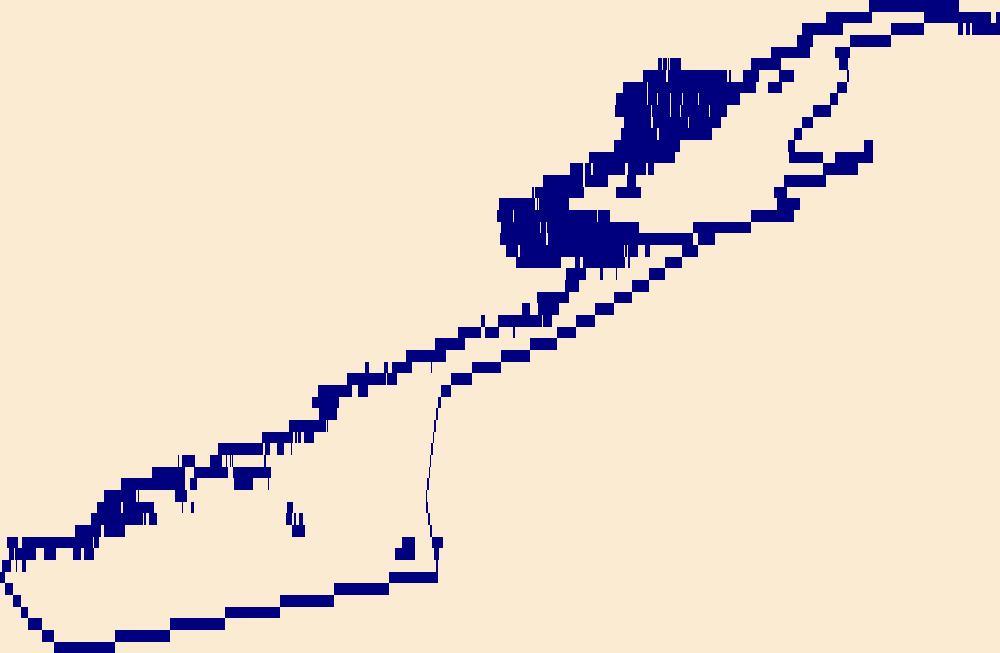Filters: Tags: Alaska (X) > Date Range: {"choice":"month"} (X)
64 results (41ms)|
Filters
Date Types (for Date Range)
Types
Contacts
Categories
Tag Types Tag Schemes |
The LANDFIRE (LF) Canadian Forest Fire Danger Rating System (CFFDRS) product depicts fuel types as an identifiable association of fuel elements of distinctive species, form, size, arrangement, and continuity. CFFDRS exhibits characteristic fire behavior under the specified burn conditions. In LF 2022 Canadian fuel models are derived from the Fuel Model Guide to Alaska Vegetation (Alaska Fuel Model Guide Task Group, 2018) and subsequent updates. The LF CFFDRS product contains the fuel models used for the Fire Behavior Prediction (FBP) system fuel type inputs. Default values assigned to the Canadian Fuel Models required to run the Prometheus fire behavior software (Prometheus, 2021) are added as attributes to the...
LANDFIRE's (LF) 2022 Forest Canopy Height (CH) describes the average height of the top of the canopy for a stand. CH is used in the calculation of Canopy Bulk Density (CBD) and Canopy Base Height (CBH). CH supplies information for fire behavior models, such as FARSITE (Finney 1998), that can determine the starting point of embers in the spotting model, wind reductions, and the volume of crown fuels. To create this product, plot level CH values are calculated using the canopy fuel estimation software, Forest Vegetation Simulator (FVS). Pre-disturbance Canopy Cover and CH are used as predictors of disturbed CH using a linear regression equation per Fuel Vegetation Type (FVT), disturbance type/severity, and time since...
LANDFIRE (LF) disturbance products are developed to provide temporal and spatial information related to landscape change. LF 2022 Fuel Disturbance (FDist) uses the latest Annual Disturbance products from the effective disturbance years of 2013 to 2022. FDist is created from LF 2022 Historical Disturbance (HDist) which in turn aggregates the Annual Disturbance products. FDist groups similar disturbance types, severities and time since disturbance categories which represent disturbance scenarios within the fuel environment. FDist is used in conjunction with Fuel Vegetation Type (FVT), Cover (FVC), and Height (FVH) to calculate Canopy Cover (CC), Canopy Height (CH), Canopy Bulk Density (CBD), Canopy Base Height (CBH),...

The High Resolution National Hydrography Dataset Plus (NHDPlus HR) is an integrated set of geospatial data layers, including the National Hydrography Dataset (NHD), National Watershed Boundary Dataset (WBD), and 3D Elevation Program Digital Elevation Model (3DEP DEM). The NHDPlus HR combines the NHD, 3DEP DEMs, and WBD to a data suite that includes the NHD stream network with linear referencing functionality, the WBD hydrologic units, elevation-derived catchment areas for each stream segment, "value added attributes" (VAAs), and other features that enhance hydrologic data analysis and routing.

The High Resolution National Hydrography Dataset Plus (NHDPlus HR) is an integrated set of geospatial data layers, including the National Hydrography Dataset (NHD), National Watershed Boundary Dataset (WBD), and 3D Elevation Program Digital Elevation Model (3DEP DEM). The NHDPlus HR combines the NHD, 3DEP DEMs, and WBD to a data suite that includes the NHD stream network with linear referencing functionality, the WBD hydrologic units, elevation-derived catchment areas for each stream segment, "value added attributes" (VAAs), and other features that enhance hydrologic data analysis and routing.
This dataset consists of one table with annual counts from population plots of Black-legged Kittiwakes and Common Murres at two seabird nesting colonies on Gull and Chisik Islands in lower Cook Inlet, Alaska.
Album caption: Aerial photograph of Redoubt Volcano, Drift River Valley, Rust Slough, Cannery Creek, and Drift River Terminal(between Rust Slough and Drift River). View to West Redoubt Volcano, Alaska. 1989-1990. Photograph by Steven R. Brantley on April 27, 1990.
Types: Map Service,
OGC WFS Layer,
OGC WMS Layer,
OGC WMS Service;
Tags: Alaska,
Redoubt Volcano,
Volcanoes and collection,
photo print
LANDFIRE's (LF) Annual Disturbance products provide temporal and spatial information related to landscape change. Annual Disturbance depicts areas of 4.5 hectares (11 acres) or larger that have experienced a natural or anthropogenic landscape change (or treatment) within a given year. For the creation of the Annual Disturbance product, information sources include national fire mapping programs such as Monitoring Trends in Burn Severity (MTBS), Burned Area Reflectance Classification (BARC) and Rapid Assessment of Vegetation Condition after Wildfire (RAVG), 18 types of agency-contributed "event" perimeters (see LF Public Events Geodatabase), and remotely sensed Landsat imagery. To create the LF Annual Disturbance...
LANDFIRE (LF) 2022 Fuel Vegetation Height (FVH) represents the LF Existing Vegetation Height (EVH) product, modified to represent pre-disturbance EVH in areas where disturbances have occurred over the past 10 years. EVH is mapped as continuous estimates of canopy height for tree, shrub, and herbaceous lifeforms with a potential range of 0-100m. Continuous EVH values are binned to align with fuel model assignments when creating FVH. FVH is an input for fuel transitions related to disturbance. Fuel products in LF 2022 were created with LF 2016 Remap vegetation in non-disturbed areas. To designate disturbed areas where FVH is modified, the aggregated Annual Disturbance products from 2013 to 2022 in the Fuel Disturbance...

The High Resolution National Hydrography Dataset Plus (NHDPlus HR) is an integrated set of geospatial data layers, including the best available National Hydrography Dataset (NHD), the 10-meter 3D Elevation Program Digital Elevation Model (3DEP DEM), and the National Watershed Boundary Dataset (WBD). The NHDPlus HR combines the NHD, 3DEP DEMs, and WBD to create a stream network with linear referencing, feature naming, "value added attributes" (VAAs), elevation-derived catchments, and other features for hydrologic data analysis. The stream network with linear referencing is a system of data relationships applied to hydrographic systems so that one stream reach "flows" into another and "events" can be tied to and traced...
This dataset consists of one table with predator disturbance information from the Common Murre breeding season (June-August) from 2016-2020 on Gull Island, Kachemak Bay, Alaska.
LANDFIRE's (LF) 2022 Forest Canopy Cover (CC) describes the percent cover of the tree canopy in a stand. CC is a vertical projection of the tree canopy cover onto an imaginary horizontal plane. CC supplies information for fire behavior models to determine the probability of crown fire initiation, provide input in the spotting model, calculate wind reductions, and to calculate fuel moisture conditioning. To create this product, plot level CC values are calculated using the canopy fuel estimation software, Forest Vegetation Simulator (FVS). Pre-disturbance CC and Canopy Height (CH) are used as predictors of disturbed CC using a linear regression equation per Fuel Vegetation Type (FVT), disturbance type/severity, and...
This .zip file contains five products that will allow users to recreate the analyses and spatial data figures used in Sergeant et al. 2023, Hypoxia Vulnerability in the Salmon Watersheds of Southeast Alaska: 1) Hypoxia vulnerability calculations (.csv file) at water temperature monitoring sites, 2) Hypoxia vulnerability calculations (.csv file) for stream reaches near hatchery release sites, 3) Habitat characteristics (.csv file) at water temperature monitoring sites, 4) R code (.R file) for recreating Figure 3, modeled contours of the estimated number of pink salmon/m2 to create hypoxia in Southeast Alaska streams across all potential combinations of velocity, depth, and water temperature, 5) Esri map package (.mpk...

The High Resolution National Hydrography Dataset Plus (NHDPlus HR) is an integrated set of geospatial data layers, including the National Hydrography Dataset (NHD), National Watershed Boundary Dataset (WBD), and 3D Elevation Program Digital Elevation Model (3DEP DEM). The NHDPlus HR combines the NHD, 3DEP DEMs, and WBD to a data suite that includes the NHD stream network with linear referencing functionality, the WBD hydrologic units, elevation-derived catchment areas for each stream segment, "value added attributes" (VAAs), and other features that enhance hydrologic data analysis and routing.
To meet the climate change planning and adaptation needs of Alaska managers and decision makers, I developed a set of statewide summaries of available climate change projections that can be further subset using GIS techniques for requests by management unit, watershed, or other location. This facilitates the development of tailored climate futures for decision makers’ regional or subregional management context. This file describes the source data and summaries for purposes of technical /scientific documentation. The methods and presentation for these datasets were adapted from products in previous USGS-approved IP products for the AKCASC Building Resilience Today project (e.g, Community of Kotlik et al. 2019)....
Note: this data release is currently being revised and is temporarily unavailable. In response to Executive Order 13817 of December 20, 2017, the U.S. Geological Survey (USGS) coordinated with the Bureau of Land Management (BLM) to identify 36 nonfuel minerals or mineral materials considered critical to the economic and national security of the United States (U.S.) (https://pubs.usgs.gov/of/2018/1021/ofr20181021.pdf). Acquiring information on possible domestic sources of these critical minerals is the rationale for the USGS Earth Mapping Resources Initiative (Earth MRI). The program, which partners the USGS with State Geological Surveys, Federal agencies, and the private sector, aims to collect new geological,...
Categories: Data,
Data Release - Under Revision;
Tags: Alabama,
Alaska,
Arizona,
Arkansas,
California,
Note: this data release is currently being revised and is temporarily unavailable. The Monitoring Trends in Burn Severity (MTBS) Program assesses the frequency, extent, and magnitude (size and severity) of all large wildland fires (wildfires and prescribed fires) in the conterminous United States (CONUS), Alaska, Hawaii, and Puerto Rico for the period 1984 and beyond. All fires reported as greater than 1,000 acres in the western U.S. and greater than 500 acres in the eastern U.S. are mapped across all ownerships. MTBS produces a series of geospatial and tabular data for analysis at a range of spatial, temporal, and thematic scales and are intended to meet a variety of information needs that require consistent data...
Categories: Data Release - Revised,
Data Release - Under Revision;
Types: Map Service,
OGC WFS Layer,
OGC WMS Layer,
OGC WMS Service;
Tags: AK,
Alaska,
Burn severity,
Burned area,
CONUS,
LANDFIRE (LF) 2022 Fuel Vegetation Cover (FVC) represents the LF Existing Vegetation Cover (EVC) product, modified to represent pre-disturbance EVC in areas where disturbances have occurred over the past 10 years. EVC is mapped as continuous estimates of canopy cover for tree, shrub, and herbaceous lifeforms with a potential range from 10% to 100%. Continuous EVC values are binned to align with fuel model assignments when creating FVC. FVC is an input for fuel transitions related to disturbance. Fuel products in LF 2022 were created with LF 2016 Remap vegetation in non-disturbed areas. To designate disturbed areas where FVC is modified, the aggregated Annual Disturbance products from 2013 to 2022 in the Fuel Disturbance...
LANDFIRE (LF) 2022 Fuel Vegetation Type (FVT) represents the LF Existing Vegetation Type Ecological Systems (EVT) product, modified to represent pre-disturbance EVT in areas where disturbances have occurred over the past 10 years. Due to shifting EVT codes and labels throughout the years, the FVT codes are based on an early version of EVT codes translated from the current version. FVT is an input for fuel transitions related to disturbance. Fuel products in LF 2022 were created with LF 2016 Remap vegetation in non-disturbed areas. To designate disturbed areas where FVT is modified, the aggregated Annual Disturbance products from 2013 to 2022 in the Fuel Disturbance (FDist) product are used. All existing disturbances...
This data package contains location data collected by the Argos System (CLS America, Inc.) from satellite transmitters attached to 116 Lesser Yellowlegs captured at multiple sites across their breeding and nonbreeding range in North America, 2018-2021. The raw data were processed to accomplish two goals: 1) flag implausible location and 2) remove locations within Joint Base Elmendorf-Richardson (JBER) and Eielson Air Force Base boundaries. Removal of locations in military land boundaries is required due to federal guidelines by Department of Defense (DoD) Public Affairs office and DoD Partners in Flight. Due to data sharing constraints of participating agencies, not all the locations (i.e., latitude and longitude)...
|

|